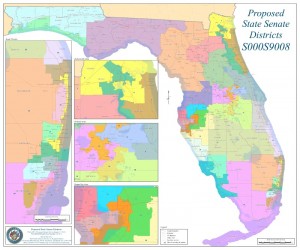Democrats and three voting-rights organizations asked a Leon County judge to throw out newly-passed congressional districts Wednesday in the first stage of a legal battle likely to make its way to the Florida Supreme Court and beyond.
In several hours of arguments before Circuit Court Judge Terry Lewis, lawyers for opponents of the map and the Legislature that approved it traded accusations of racial and political gerrymandering. The case marks the first time that a court has reviewed the congressional plan under the anti-gerrymandering Fair Districts amendments, approved by voters in a November 2010 referendum.
The case is separate from an automatic review of the legislative maps by the Florida Supreme Court, which is expected to hear arguments about a second draft of redistricting plans for the state Senate on Friday.
During Wednesday hearings, opponents hammered away at the plans drawn by the GOP-dominated Legislature as an attempt to continue to gerrymander the state to preserve a strong majority in the state’s congressional delegation despite a slight Democratic edge in voter registration.
They zeroed in on the district currently held by Democratic Congresswoman Corrine Brown, which snakes through eight counties as it winds from Duval County to Orange County, carving out enclaves of black voters to create a district likely to elect a candidate favored by African-Americans.
The Florida Democratic Party and a coalition of voting-rights groups that includes the League of Women Voters of Florida, Common Cause Florida and Hispanic advocacy group National Council of La Raza argue that the Legislature packed more voters than it needed into the district in order to help neighboring Republicans.
In the process, they say, lawmakers violated a Fair District standard requiring districts to be compact.
“Even though the state constitution was amended to make compactness now a constitutional requirement, they actually made the district less compact, not more compact,” said Marc Elias, a lawyer for the Democratic Party.
Even Lewis, while questioning the map, said the district appeared “really bizarrely shaped.”
But lawyer George Meros, arguing for the Legislature, said there was a “nefarious” purpose to the alternative plans put forward by Democrats and the coalition: scatter black voters for political ends.
“What they are trying to do with minority protections is to spread as many African Americans out of minority districts into adjoining districts that will elect white Democrats. … They are trying to go back to a darker time in our past and have African Americans submerged in white districts,” Meros said.
Lewis promised to rule quickly on a motion by Democrats and the voting-rights groups to throw out the maps without a full, fact-intensive trial. Whatever the ruling, it is likely to go to the Supreme Court.
And even that might not be the end of the battle. The state NAACP is trying to intervene in the trial on the side of the Legislature, and a decision by the Supreme Court to have new maps drawn up that water down the black voting-age population in Brown’s district could be challenged in federal court under the Voting Rights Act.
“No matter what the Florida Supreme Court decides, that’s almost certainly not going to be the last say,” said Aubrey Jewett, a political science professor at the University of Central Florida who recently wrote a book chapter about the state’s congressional redistricting.
By Brandon Larrabee



